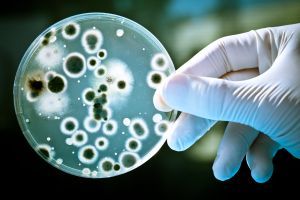Tyrosol-functionalized chitosan-gold nanoparticles against fungal biofilms

Fungi of the Candida genus can be responsible for serious skin infections, especially as biofilms. To find an alternative treatment method for fungal biofilms, chitosan-gold nanoparticles were coupled with the quorum sensing molecule Tyrosol in the study presented here.
IN SITU SYNTHESIZED TYROSOL-FUNCTIONALIZED CHITOSAN-GOLD NANOPARTICLES AS VERSATILE ANTIFOULING COATING ON IMPLANT SURFACES AGAINST CANDIDA SPP.
T. C. Yadav, P. Gupta, S. Saini, S. Mohiyuddin, V. Pruthi, and R. Prasad, Plausible Mechanistic Insights in Biofilm Eradication Potential against Candida spp. Using In Situ-Synthesized Tyrosol-Functionalized Chitosan Gold Nanoparticles as a Versatile Antifouling Coating on Implant Surfaces, ACS Omega 2022 7 (10), 8350-8363, DOI: 10.1021/acsomega.1c05822
Fungi of the Candida species cause superficial to deeper skin infections. In immunocompromised patients, mortality rates of up to 40% occur, especially with resistant strains. The virulent properties of Candida are dependent on biofilm formation. This mainly occurs on surfaces of foreign bodies such as implants. There, the cells encapsulate themselves in a self-secreted extracellular matrix (ECM). The ECM consists of proteins, various biomolecules, hydrolytic enzymes (e.g. lipases, proteases, phospholipases) and persister cells, which have a lower division rate and are able to actively pump out active substances. In addition, it is difficult to combat these with antibiotics. In biofilm, cells communicate via quorum sensing. In this process, tyrosol is responsible for hyphal formation in the biofilm formation. However, if tyrosol is added externally, it has an antagonistic effect and can be used to dissolve biofilms.
Nanoparticles are one possibility for introducing tyrosol externally into the biofilm as a quorum sensing molecule. Nanoparticles improve cell uptake, have a high surface-to-volume ratio, and can release drugs in a delayed manner. Gold and chitosan are of particular interest as nanoparticle materials because both substances are antibacterial and have low cytotoxicity and biocompatibility.
For this reason, in the study presented here, gold, chitosan, and tyrosol were synthesized in situ into nanoparticles (Chi-TY-AuNPs) and the antifungal and antibiofilm properties were investigated on C. albicans and C. galbrata. In addition, the mode of action of Chi-TY-AuNPs on ROS formation, cell surface hydrophobicity, ECM composition, and membrane ergosterol content was considered in more detail.
RESULTS
- Confirmation of Chi-TY-AuNP formation via FTIR
- A spherical shape, as well as a size of 10 - 15 nm was observed via AFM
- Drug loading capacity of 46.08% in 100 mg Chi-TY-AuNPs
- Evidence of antifugal properties by MIC80 values of Chi-TY-AuNPs of 200 µg/ml (C. albicans) and 400 µg/ml (C. glabrata), respectively, and MCF values at 800 µg/ml
- Above 400 µg/ml Chi-TY-AuNPs in C. albicans and C. glabrata: absence hyphal network and wrinkled cells (C. albicans), and cells with pores on the surface (C. glabrata)
- Chi-TY-AuNPs inhibited hyphal formation and reduced the number of germ tubes in C. albicans
- Hydrophobicity did not play a role in the antibiofilm properties of Chi-TY-AuNPs
- Intense red staining of C. albicans and C. glabrata biofilms treated with Chi-TY-AuNPs after live-death staining with FDA-PI
- High PI fluorescence indicated ROS accumulation in Candida spp. cells by Chi-TY-AuNPs
- C. albicans showed no change in ergosterol content in the presence of Chi-TY-AuNPs, while C. glabrata showed decreased ergosterol concentration compared to control
- Improved biocompatibility of Chi-TY-AuNPs compared to Chi-AuNPs
Conclusions: In the presented study, Chi-TY-AuNPs were successfully synthesized and characterized using various biophysical methods. Moreover, the antifungal and biofilm-fighting potential of the nanoparticles was demonstrated. Chi-TY-AuNPs seem to have an effect on ROS and ECM formation as well as ergosterol content of both Candida strains. However, further studies are needed there to further investigate the therapeutic and mechanistic effect of Chi-TY-AuNPs. Nevertheless, the results of the study showed the potential of Chi-TY-AuNPs as an alternative treatment against Candida biofilms e.g. on implant surfaces. Link to article: https://pubs.acs.org/doi/10.1021/acsomega.1c05822?ref=PDF


